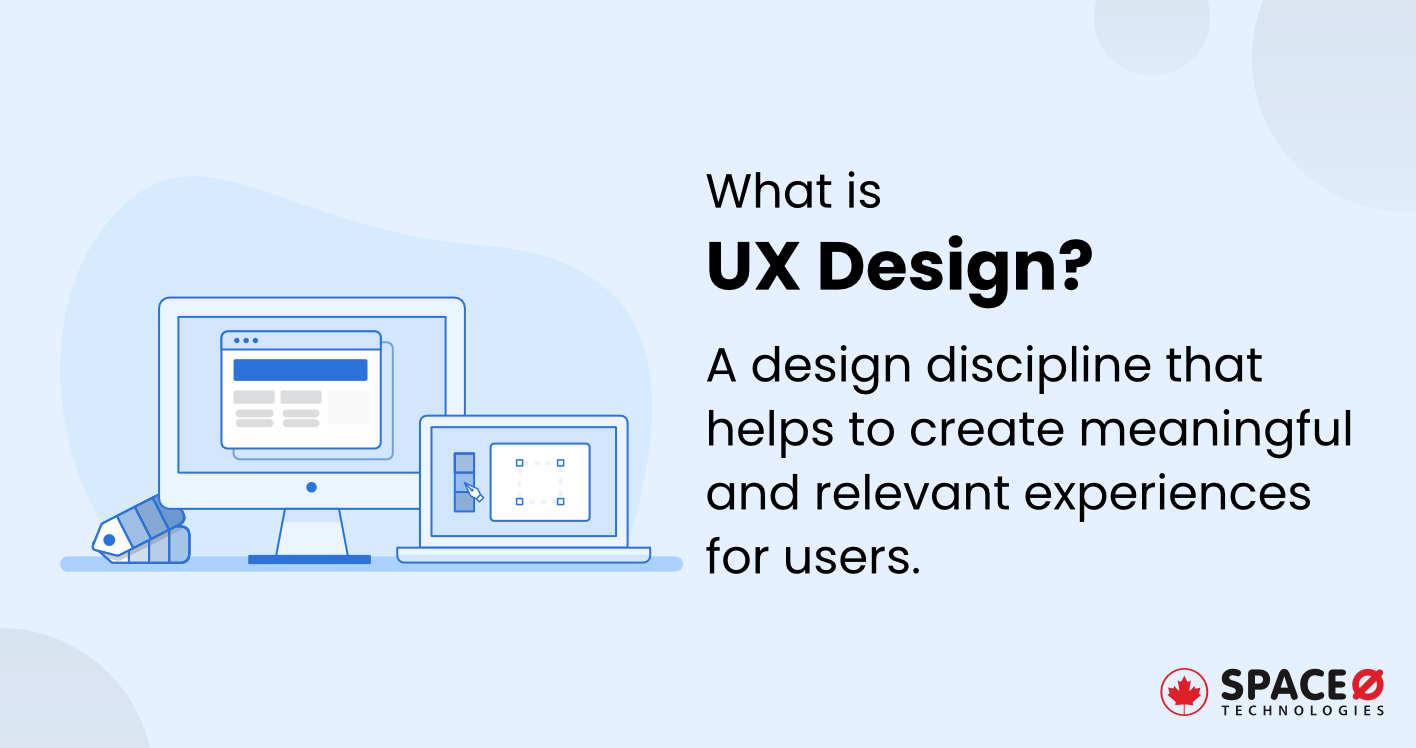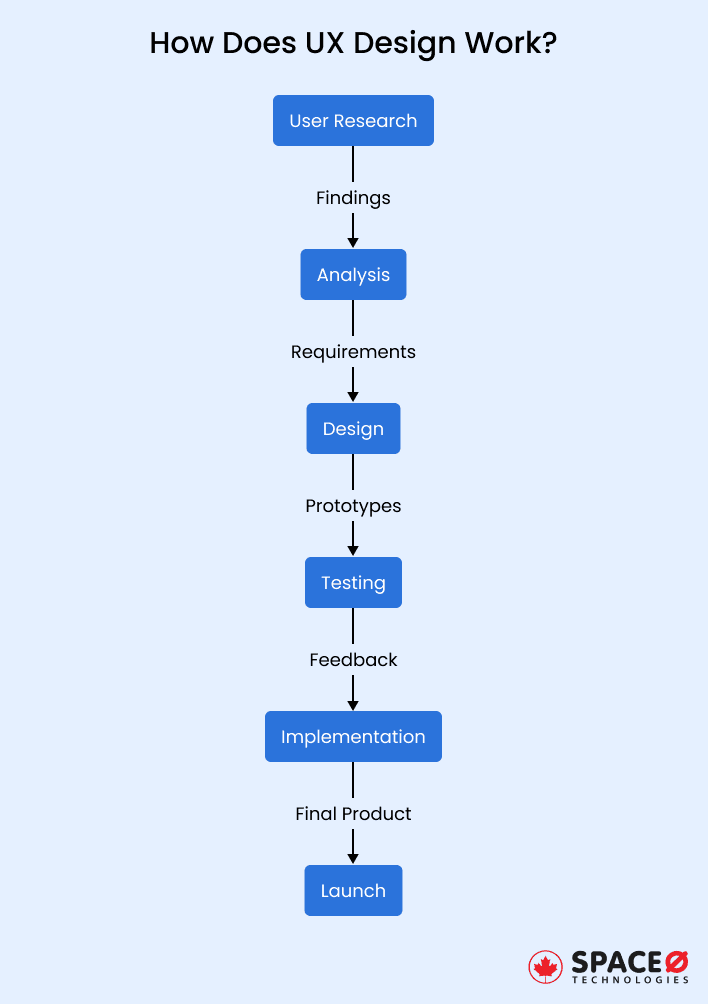
What is UX Design? [Definition + Elements + Process]
Table of Contents
What is UX Design?
UX design refers to designing software products that deliver meaningful and seamless experiences to users. Mainly, the UX design focuses principally on the user’s journey to solve a problem and ensure the process is easy, efficient, and enjoyable. A UX design represents the user’s complete interaction with a company, its services, and its products.
The purpose of UX design is about creating a connection between users and software products in a way that provides overall the best user experience and satisfaction. By following the proper software design process, a UX design is created that follows from understanding the product requirements to user testing of the design.
If you are interested to learn about the whole process of creating UX design, here is a comprehensive guide on the software design process. By following this guide, you learn about the core steps that help to create interactive designs of the final software product.
How Does UX Design Process Work?
Let’s understand the UX design process and what are the different phases in it. Check the following diagram that illustrates the whole process in detail.

Now, learn about each phase in detail further.
Each phase of the UX design process is valuable and the entire process revolves around these key phases.
Understanding User Personas and Context
Within the first step, detailed research gets done to understand user behaviours, needs, and motivations via observation techniques, task analysis, and feedback methods. For creating user personas, understanding the overall requirements is necessary. To create user personas, a UX designer needs to empathize with the users and graphic design with specific requirements in mind.
Information Architecture and Wireframing
A UX designer sketches out the structural design of shared information to enhance usability and accessibility. Proper layouts are created which are known as wireframes. Wireframes act as a blueprint in the initial project development that helps UX designers to developers with the overall development of the final product by navigating through user interfaces created in wireframes and prototypes. Do you want to learn more about wireframing? Explore this post on what is wireframing and learn about its types and benefits.
Prototyping and User Testing
At this step, prototypes are created to test a new design. Certainly, a prototype is a combination of interactive mockups tied up together to showcase the overall process of the products. The interactive mockups are the close version of the final products which represent how a software product will work. Prototypes are used in user testing to gather feedback and identify any potential issues before the final development.
Final Implementation and Iterative Design
After resolving the problems identified during testing, the design moves into the final development phase. Even after the product launch, UX design is an iterative process that continuously evolves based on user feedback.
Why is UX Design Essential?
Here are the reasons why UX design is important.
Focusing on the User Requirements
UX design is about understanding and addressing the needs of the users and easing the human-computer interaction that adds value. An effective user-centered design means creating a product that provides solutions to users’ problems and enhances their interaction with the product. By focusing on the users’ needs, you are more likely to create a software product that is not only useful but also resonates with your target audience.
Creating Positive and Unique Experiences
As a UX designer, creating a positive user experience leads to user satisfaction and loyalty is vital for a product’s success. If end-users find the product enjoyable and easy to use, they are likely to continue using it and also recommend it to their colleagues, friends, and family members. However, in contrast, poor user experience can lead to frustration, negative reviews, and ultimately, a decline in usage.
Making a Simple and Flawless Custom Journey
A well-crafted user experience UX design helps guide users through a product and lean them on a customer journey that is beneficial to your business and seamless for your end users. For that, UX designers need to properly use their UX design skills that help them to create and encourage users to more deeply, spend more time on your product, and most beneficial to your business. This way, a user interacts with the product and results in the purchases.
Reducing Software Development Costs
Investing in UX design can also result in financial benefits. Addressing usability issues early in the design process can save time and resources in the long run. Making changes after a digital product has been developed can be costly and time-consuming. However, by conducting user research, usability testing, and iterative design during the development process, these issues can be identified and resolved early on.
Enhancing the Accessibility of the Overall Software
Lastly, good UX design promotes accessibility. A user experience design ensures that a product or service is usable by as many people as possible, regardless of their abilities or circumstances. By considering accessibility in your design, you can create products that are not only inclusive but also reach a larger audience.
What are the Elements of UX Design?
A UX design consists of multiple elements that help you to create effective, efficient, and satisfactory user interaction which helps you to create an attractive user interface. Let’s learn about each one.
- Usability: Within the UX design, usability refers to how effectively, efficiently, and satisfactorily a user can interact with the user interface.
- Interaction Design: This element involves designing engaging interfaces with well-thought-out behaviours.
- Information Architecture: This is the art and science of structuring and organizing information to help users understand and navigate through the product.
- Visual Design: This is about creating and improving the user’s interaction with the software product using images, colours, shapes, typography, and form.
If you are confused between the user interface and user experience, read this post on the meaning of the user interface, its key components, and key principles.
What is the Difference Between UX and UI Design?
While UX design is about the overall feel of the experience, user interface design is about how the software product’s surfaces look and function. A simple way to remember this is that UI Design is about how things look, while UX design is about how things work and feel.
In conclusion, UX design is the process of designing a seamless, efficient, and enjoyable interaction between a user and a software product. The UX design process is an evolving field that requires you to design software providing unique user satisfaction and making it more enjoyable. The objective measure of good UX design is how it works for the end user, making it a fundamental aspect of product development.
All our projects are secured by NDA
100% Secure. Zero Spam
*All your data will remain strictly confidential.
Trusted by


Bashar Anabtawi
Canada
“I was mostly happy with the high level of experience and professionalism of the various teams that worked on my project. Not only they clearly understood my exact technical requirements but even suggested better ways in doing them. The Communication tools that were used were excellent and easy. And finally and most importantly, the interaction, follow up and support from the top management was great. Space-O not delivered a high quality product but exceeded my expectations! I would definitely hire them again for future jobs!”

Canada Office
2 County Court Blvd., Suite 400,
Brampton, Ontario L6W 3W8
Phone: +1 (437) 488-7337
Email: sales@spaceo.ca




